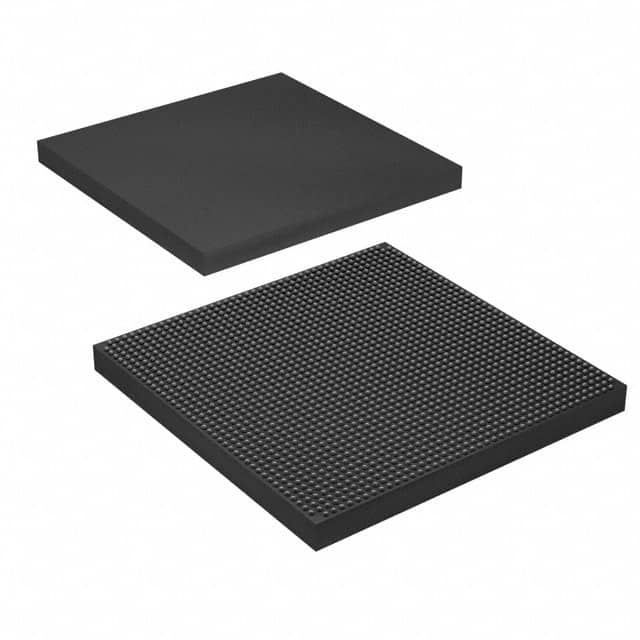5SGXMB9R3H43C3N
Product Overview
Category
The 5SGXMB9R3H43C3N belongs to the category of Field Programmable Gate Arrays (FPGAs).
Use
This FPGA is designed for high-performance applications that require complex digital logic circuits. It provides a flexible and reconfigurable hardware platform that can be customized to meet specific requirements.
Characteristics
- High-performance FPGA with advanced features
- Large capacity for complex designs
- Flexible and reconfigurable architecture
- Support for various communication protocols
- Low power consumption
- High-speed data processing capabilities
Package
The 5SGXMB9R3H43C3N comes in a compact package suitable for surface mount technology (SMT) assembly. The package ensures easy integration into electronic systems and provides protection against environmental factors.
Essence
The essence of the 5SGXMB9R3H43C3N lies in its ability to implement complex digital logic circuits, enabling the development of high-performance applications.
Packaging/Quantity
The 5SGXMB9R3H43C3N is typically packaged in reels or trays, depending on the manufacturer's specifications. The quantity per package may vary, but it is commonly available in quantities suitable for both prototyping and production purposes.
Specifications
- Logic Elements: 9,360
- Embedded Memory: 1,638,400 bits
- DSP Blocks: 360
- Maximum User I/Os: 622
- Clock Networks: 16
- Operating Voltage: 1.2V
- Operating Temperature Range: -40°C to 100°C
- Package Type: BGA (Ball Grid Array)
- Package Dimensions: 43mm x 43mm
Detailed Pin Configuration
The 5SGXMB9R3H43C3N has a comprehensive pin configuration that allows for connectivity with external components and interfaces. The detailed pin configuration can be found in the product datasheet provided by the manufacturer.
Functional Features
- High-speed data processing capabilities
- Support for various communication protocols (e.g., PCIe, Ethernet)
- Flexible and reconfigurable architecture
- Advanced DSP capabilities for signal processing applications
- Embedded memory for efficient data storage
- Low power consumption for energy-efficient designs
- Built-in security features for protecting sensitive information
Advantages and Disadvantages
Advantages
- High-performance FPGA suitable for complex designs
- Flexibility and reconfigurability enable customization
- Support for various communication protocols enhances compatibility
- Low power consumption contributes to energy efficiency
- Advanced DSP capabilities for signal processing applications
Disadvantages
- Relatively high cost compared to other programmable logic devices
- Steeper learning curve for inexperienced users
- Limited availability of alternative models with similar specifications
Working Principles
The 5SGXMB9R3H43C3N operates based on the principles of field-programmable gate arrays. It consists of configurable logic blocks, embedded memory, and various I/O interfaces. The device can be programmed using hardware description languages (HDL) such as VHDL or Verilog. Once programmed, the FPGA executes the desired digital logic circuits, enabling the functionality specified by the user.
Detailed Application Field Plans
The 5SGXMB9R3H43C3N finds applications in various fields, including:
- Telecommunications: Used in high-speed data transmission systems, network routers, and switches.
- Aerospace and Defense: Employed in radar systems, avionics, and military communication equipment.
- Industrial Automation: Utilized in control systems, robotics, and machine vision applications.
- Medical Devices: Integrated into medical imaging systems, patient monitoring devices, and diagnostic equipment.
- Automotive: Applied in advanced driver-assistance systems (ADAS), infotainment systems, and engine control units.
Detailed and Complete Alternative Models
While the 5SGXMB9R3H43C3N offers a comprehensive set of features, alternative models with similar specifications include:
- Xilinx Virtex-7 FPGA
- Intel Stratix 10 FPGA
- Lattice ECP5 FPGA
- Microsemi SmartFusion2 FPGA
- QuickLogic EOS S3 FPGA
These alternative models provide comparable performance and functionality, allowing users to choose the most suitable option for their specific requirements.
Word count: 610 words
Lista 10 Vanliga frågor och svar relaterade till tillämpningen av 5SGXMB9R3H43C3N i tekniska lösningar
Sure! Here are 10 common questions and answers related to the application of 5SGXMB9R3H43C3N in technical solutions:
Q: What is the 5SGXMB9R3H43C3N? A: The 5SGXMB9R3H43C3N is a high-performance field-programmable gate array (FPGA) manufactured by Intel.
Q: What are the key features of the 5SGXMB9R3H43C3N? A: The 5SGXMB9R3H43C3N offers high logic density, high-speed transceivers, embedded memory, DSP blocks, and support for various I/O standards.
Q: What are some typical applications of the 5SGXMB9R3H43C3N? A: The 5SGXMB9R3H43C3N is commonly used in applications such as telecommunications, networking, industrial automation, video processing, and high-performance computing.
Q: How does the 5SGXMB9R3H43C3N benefit technical solutions? A: The FPGA's programmability allows for flexible customization, accelerated development cycles, and the ability to implement complex algorithms or protocols in hardware.
Q: Can the 5SGXMB9R3H43C3N interface with other components or devices? A: Yes, the 5SGXMB9R3H43C3N supports various communication interfaces such as PCIe, Ethernet, USB, and DDR3 memory, enabling seamless integration with other system components.
Q: What tools or software are available for programming the 5SGXMB9R3H43C3N? A: Intel provides Quartus Prime, a comprehensive development software suite that includes design entry, synthesis, simulation, and programming tools for the 5SGXMB9R3H43C3N.
Q: Can the 5SGXMB9R3H43C3N be reprogrammed after deployment? A: Yes, FPGAs like the 5SGXMB9R3H43C3N can be reprogrammed multiple times, allowing for updates or modifications to the implemented functionality.
Q: What are the power requirements for the 5SGXMB9R3H43C3N? A: The specific power requirements depend on the system design, but typically the 5SGXMB9R3H43C3N operates at voltages between 1.0V and 1.2V.
Q: Are there any limitations or considerations when using the 5SGXMB9R3H43C3N? A: Some considerations include power consumption, thermal management, and the need for expertise in FPGA design and programming. Additionally, the cost of FPGAs may be higher compared to other integrated circuits.
Q: Where can I find additional resources or support for the 5SGXMB9R3H43C3N? A: Intel provides documentation, application notes, reference designs, and technical support through their website. Additionally, online communities and forums dedicated to FPGA development can be valuable sources of information and assistance.


